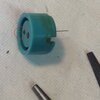Sounds like you are correct in your thinking.
Using a refitted (best of two) may be your issue.
These units are not to be opened up, or taken apart, per the factory service manual etc.
The yoke is a very close measurement, and its easily possible to adjust it incorrectly, which will disable the unit buy blocking the port with the rubber skirt.
On the backside of the SMC (2-8mm head bolts) there is a small screen cartridge that filters stuff. This also has the same very small port, and often is clogged up.
The hole is so small that the only thing that fill fit through it is an acupuncture needle. And it is impossible to do so without damage to the o-ring, and/or filter cartridge.
The bore, piston, and/or skirts are not the issue.
Your filter behind the unit is probably clogged up.
This part is not available from Honda.
This is why replacing the entire unit with a NEW unit is advisable, and usually the only option that fixes things.
The other point I'll make is, when your rear caliper is locked up, and you say bleeding off the pressure by opening the bleeder corrects it, you may be missing the point of alignment issues.
While it may appear to be a pressure issue, because the bleeder seems to fix it, by relieving the pressure via the bleeder, will also allow the rear brake caliper bracket to shift/settle/re-align itself, which may be your issue.
Inspect the rear caliper mounting bracket in three areas.
1. look inside the egg shaped hole where the stopper plug sits, do you see flutes, or spiral markings? If so, this is DAMAGE.
2. look at the lower ledge where the front foot of the brake pads sit, is it loose, or worn away allowing the pads to shift around, binding things?
3. look at the sliding dowels that connect the caliper to the bracket, are they dry/dirty/bent/damaged? Often folks will try and remove these dowels thinking they have to, to pull the caliper apart, and cross thread them back in, or over tighten them, swaging the into the soft aluminum, and misaligning the pin/caliper etc.
I will try and attach a couple pictures of these comments, what you are looking at is DAMAGE and should be replaced.
I am providing pictures of the cartridge, and needle just to give you an idea of the size your dealing with. I strongly urge you NOT to try and take the SMC apart, and advice you to replace it with a new OEM unit if that is called for.






















